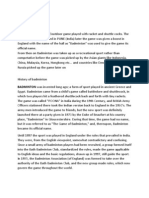0 ratings0% found this document useful (0 votes)
136 viewsDarts PDF
Darts PDF
Uploaded by
Yvonne Alexis MulleThe document provides a detailed history of darts from its origins in medieval England to its development over subsequent centuries. It notes that darts likely began as a game played by King Henry VIII's archers for practice. Over time, the game spread throughout England and was taken by pilgrims to America. Key developments included the standardized dartboard numbering system invented in 1896 and the establishment of organized competitions in the early 1900s. The document also reviews the typical equipment used in darts, including dartboard specifications and the main components of a dart.
Copyright:
© All Rights Reserved
Available Formats
Download as PDF, TXT or read online from Scribd
Darts PDF
Darts PDF
Uploaded by
Yvonne Alexis Mulle0 ratings0% found this document useful (0 votes)
136 views49 pagesThe document provides a detailed history of darts from its origins in medieval England to its development over subsequent centuries. It notes that darts likely began as a game played by King Henry VIII's archers for practice. Over time, the game spread throughout England and was taken by pilgrims to America. Key developments included the standardized dartboard numbering system invented in 1896 and the establishment of organized competitions in the early 1900s. The document also reviews the typical equipment used in darts, including dartboard specifications and the main components of a dart.
Original Title
Darts.pptx.pdf
Copyright
© © All Rights Reserved
Available Formats
PDF, TXT or read online from Scribd
Share this document
Did you find this document useful?
Is this content inappropriate?
The document provides a detailed history of darts from its origins in medieval England to its development over subsequent centuries. It notes that darts likely began as a game played by King Henry VIII's archers for practice. Over time, the game spread throughout England and was taken by pilgrims to America. Key developments included the standardized dartboard numbering system invented in 1896 and the establishment of organized competitions in the early 1900s. The document also reviews the typical equipment used in darts, including dartboard specifications and the main components of a dart.
Copyright:
© All Rights Reserved
Available Formats
Download as PDF, TXT or read online from Scribd
Download as pdf or txt
0 ratings0% found this document useful (0 votes)
136 views49 pagesDarts PDF
Darts PDF
Uploaded by
Yvonne Alexis MulleThe document provides a detailed history of darts from its origins in medieval England to its development over subsequent centuries. It notes that darts likely began as a game played by King Henry VIII's archers for practice. Over time, the game spread throughout England and was taken by pilgrims to America. Key developments included the standardized dartboard numbering system invented in 1896 and the establishment of organized competitions in the early 1900s. The document also reviews the typical equipment used in darts, including dartboard specifications and the main components of a dart.
Copyright:
© All Rights Reserved
Available Formats
Download as PDF, TXT or read online from Scribd
Download as pdf or txt
You are on page 1of 49
Dart
Emmanuel Presquito, Samantha Feliciano, Jonah Mae Ventura, Elizabeth Astre,
Janice Pama, Arl Locsin
Darts
A lot has been written over the years about
the history of darts, but finding good credible
darts history information is a completely
different story. One fact no-one can dispute
when it comes to the history of darts is that
the game of darts originated in England.
Darts
Darts has been played in pubs and taverns all
over the UK for the past 100 years and more.
History of Darts during
Medieval Times
History of Darts during Medieval Times
Much is speculated but if rumor
holds true, the game of darts had its
origin during the reign of King Henry
VIII of England.
History of Darts during Medieval Times
It is believed that he told his archers to
practice their arching skills all year
round so they would be sharp and
ready for battle at any time.
History of Darts during Medieval Times
While practicing outside some archers,
instead of shooting, started throwing
their arrows as a means of fun. Maybe
the thinking was, "anyone can shoot
accurately lets see who can throw
accurately".
History of Darts during Medieval Times
The bottom of an overturned wine or
ale (beer) barrel was used as a “target”.
An interesting fact about the word
"target". The bottom of a wine / beer
barrel was called a “butt”, which
originated via archery from the French
word “butte”, meaning “target”.
History of Darts during Medieval Times
The game didn’t just stay in England. It
wasn’t long before people in other
countries started to enjoy the game.
History of Darts during Medieval Times
Reports suggest that the Pilgrims who
left England in 1620 aboard the
Mayflower, played darts for fun and
entertainment on their voyage across
the sea to America.
Darts History – 1800’s
Darts History – 1800’s
Many interesting stories exist with regard
to darts. One such story was about a
game which originated in 1844 called
"Puff and Dart". It seems that while some
people were throwing the darts others
tried to start a new type of game by
using a blowpipe to blow the dart into
the board.
Darts History – 1800’s
Apparently the game was quickly
banned because a London dart blower
made the mistake of sucking the
blowpipe instead of blowing. The dart
went into his digestive system, which
caused him to die a few days later.
Darts History – 1800’s
In 1896, a carpenter from Lancashire in
England, by the name of Brian Gamlin,
invented the dartboard numbering
layout of today.
Darts History – 1800’s
The numbering system of modern day
dartboards, has the number 20 at the
top, followed by the number 1 in a
clockwise direction, then the number 18
etc. Brian Gamlins numbering sequence
layout, was specifically created with the
intention to penalize inaccuracy.
Darts History – 1800’s
Although many papers were written about
the billions of different dartboard
numbering sequences that could be
devised with 20 numbers, it is widely
accepted, that Brian Gamlins numbering
sequence layout, is the closest to perfect
randomness you will ever find. (Brian
Gamlin died in 1903 before he could
patent his idea)
Darts History – 1800’s
Doubles and trebles were not part of the
dartboard’s make-up during this time. The
highest score was the bullseye. The dart,
at this stage, consisted of a 4 inch long
piece of wood called the barrel, with a
metal point on the one side and feathers
for the dart flight on the opposite side.
Darts History – 1900’s
Darts History – 1900’s
The first paper folded dart flight was
patented in 1898 by an American and in
1906 an Englishman patented the first
metal barrel. Much is also speculated
about the distance from where the darts
were thrown, commonly known as the
“oche”.
Darts History – 1900’s
The first paper folded dart flight was
patented in 1898 by an American and in
1906 an Englishman patented the first
metal barrel. Much is also speculated
about the distance from where the darts
were thrown, commonly known as the
“oche”.
Darts History – 1900’s
Other words for "the oche" is the “Throw
line” or “Toe Line”. The throwing line is a
line that a dart player stands behind when
throwing his or her darts.
Two theories exist about the origins of
the term “oche”
First “oche” theory Second “oche” theory
The first theory is that the The second theory about the
word “oche” had its origin origin of the word “oche”
from a brewery in the West also considers “oche” to be
Country of England called derived from the word
“Hockey and Sons” or “hockey”, but from a total
“S.Hockey and Sons”. The different source. An English
original throwing distance newspaper, News of the
for darts was 9 feet. It is said World, sponsored darts
that “Hockey & Sons” competitions in the 1920’s.
delivered bottled beer to
pubs which came in They used the word “hockey”
wooden crates that were for the throwing line in their
exactly 3 feet long. “tournament rules”.
Darts History – 1900’s
The game of darts was firmly established
by the end of World War 1 and many pubs
throughout the country had dart teams at
that stage. Competitions with substantial
prizes were being held on a regular basis
and News of the World, a popular British
Sunday newspaper, sponsored the first big
competition in 1927/28, called the "News
of the World Individual Darts
Championship".
Dartboard setup
instructions
Height from centre of Bull to the Ground
Setup the dartboard height to measure
5 Feet 8 Inches from the centre of the
dartboard (the centre of the bull) to the
ground. The height can also be
measured as 68 inches, 1.73 meters or
173 centimetres.
Distance from the ground to the Oche
Setup the dartboard throwing distance
to measure 7 Feet 9 and a quarter inch
from the front of the dartboard to the
front of the Oche (Throwing Line). The
throwing distance can also be measures
as 93.25 inches, 2.37 meter or 237
centimetres.
Distance from centre of Bull to the Oche
After your dartboard has completely
been setup, it is a good idea to
measure the distance from the centre
of the bull to the oche throwing line) to
make 100% sure all measurements are
correct.
Distance from centre of Bull to the Oche
If this distance shows to be 9 Feet 6
Inches then you know your dartboard
was setup correctly. The distance from
the centre of the bull to the throwing
line can also be measured as 115.35
Inches, 2.93 meter or 293 centimetres.
Distance from centre of Bull to the Oche
If this distance shows to be 9 Feet 6
Inches then you know your dartboard
was setup correctly. The distance from
the centre of the bull to the throwing
line can also be measured as 115.35
Inches, 2.93 meter or 293 centimetres.
Darts - Equipment
Dart Board
A fine quality board consists of sisal
fibers or boar bristles and cork. An 18
inch diameter board is divided into 20
sections. Thin metal structures are used
to design the dividing lines and with the
same materials the numbers are
designed.
Dart Board
Sometimes the manufactures opt for
printing number formats. The board
should be positioned on the wall in such
a manner that the bull’s eye should be
5ft 8 inch above the floor.
Dart Board
The wires and staples that are fixed on
the board are known as spiders. They
are generally made up of thin steels so
a normal dart cannot penetrate them.
In case the dart hits the spiders it will
bounce back and the player will get no
points.
Darts Equiptment and Gears
The four main parts of a dart are:
➢ The point
➢ The shaft
➢ The grip
➢ The flight
The point
➢ It can be either fixed or
movable. The tip is usually soft
but can be made up of steel
sometimes.
➢ Fixed points are popular, but
they often bounce back due
to spiders.
➢ The movable point overcomes
this disadvantage by retracting
itself from the spiders just
before its contact.
➢ The back side of the dart is so
designed to give necessary
momentum to hit the target.
➢ Steel darts provide more sharp
teeth than that of the soft tip.
The Shaft
➢ The part of a dart which the player
uses to hold before throwing helps
the player to get good grip.
➢ The materials used for the
construction of the shaft are
generally plastic or aluminium or
the combination of both.
➢ The biggest disadvantage with
plastic is that it produces crack
when gets hit with the board very
hardly but same is not the case
with aluminium which is why
aluminium darts cost little bit more
than plastics do.
➢ These days, spinning darts are very
much popular. They tend to spin
while being thrown, to prevent it
from getting damaged.
The grip
➢ While throwing the dart, the
grip is very much important
in giving a hard push.
➢ Better control over the dart
comes from better hold and
that is what the purpose of
grip over here.
➢ Grip design may vary from
person to person as they
know better which design
will make them comfortable
while handling a dart.
The Flight
➢ It is nothing but the fin like
structure that has been put at
the back side of the dart.
➢ It is usually made up of
feathers but nowadays,
manufactures are putting
nylon and polyester materials
while designing it.
➢ Flight serves the purpose of
giving a perfect drag to the
dart so that it can sail smoothly
in the air towards its target.
➢ The player should practice with
different flights on the dart to
know which one suits him
better.
Darts - Equipment
These four parts helps the player to
handle the dart to get good throwing
results. A dart can be made up of either
wooden or brass or tungsten. Sometimes
Nickel silver type darts are also used.
Darts - Equipment
Depending upon your level of comfort
you can choose the dart. However; we
will also discuss about the process of
choosing a dart in this article.
Darts – Rules
Darts - Rules
▶ The dartboard shall be setup or fastened so that the center
of the bullseye is exactly 5 Ft 8 Inches or 1.73 meters high.
▶ The minimum throwing distance shall be 7 Ft 9 ¼ Inches or
2.37 meters from the face of the board, when measured
horizontally.
▶ The toe-line or throwing line shall be clearly marked and be
at least 18 inches or 45.72 centimeters long.
▶ Order of starting shall be determined by throwing closest to
the bullseye with one dart. The winner shall throw first in the
first leg, and in odd alternate legs. The loser shall throw first
in the second leg and if applicable in alternate even legs
thereafter.
▶ Any darts may be used.
Darts - Rules
▶ A throw consists of three darts except where a game is
finished in less.
▶ Darts cannot be re-thrown, and only darts sticking in the
board count to your score.
▶ On request, a player may be told what number he has
scored, or what number he requires for the game by the
score announcer, but not how to get it.
▶ If the number required for game is exceeded in the
course of a throw, the throw ceases, and no account is
taken of the score obtained during that throw.
▶ The inner bull(50) counts double of the outer bull(25).
Darts – Rules
In a game of 501 the object is for one
player or a team to be the first to reach
zero from starting total of 501. In simple
terms, after three darts are thrown, the
throwing player subtracts the total
scored from his current total until he
reaches zero.
Darts – Rules
In a game of 501 the object is for one
player or a team to be the first to reach
zero from starting total of 501. In simple
terms, after three darts are thrown, the
throwing player subtracts the total
scored from his current total until he
reaches zero.
Darts – Rules
In order to reach zero each player must
finish by throwing a double i.e. if player
one has 36 remaining he must hit
double 18 to win, while if player two has
45 remaining he must hit single 5,
double 20 to win - or a another
combination of scores provided the
final dart scores on a double.
Darts – Officials
Darts - Officials
The Darts Referee and Umpire Resources
and Collection page contains links to
darts rules, contacts and associations.
You might also like
- Bowling ReportingDocument9 pagesBowling ReportingChristine Joy RodriguezNo ratings yet
- Volleyball Court DimensionsDocument7 pagesVolleyball Court DimensionssamgyupNo ratings yet
- History of DartsDocument8 pagesHistory of DartsMikaila Denise LoanzonNo ratings yet
- Assignment in PEDocument7 pagesAssignment in PEBesol DichosoNo ratings yet
- History of DartsDocument5 pagesHistory of DartsbernardNo ratings yet
- DARTSDocument34 pagesDARTSSheenah DelfinNo ratings yet
- DartsDocument1 pageDartsPhilene Rose AbratiguinNo ratings yet
- Introduction To Basketball: OutlineDocument3 pagesIntroduction To Basketball: OutlineGela ReyesNo ratings yet
- Official Futsal RulesDocument5 pagesOfficial Futsal RulesKamil IyNo ratings yet
- History of BadmintonDocument4 pagesHistory of Badmintondorene alabatNo ratings yet
- Types of ShotsDocument4 pagesTypes of Shotsjr_rudolf100% (1)
- Lesson 3 - (Arnis)Document17 pagesLesson 3 - (Arnis)Victorino LopezNo ratings yet
- DartsDocument36 pagesDartsJenelyn BestudioNo ratings yet
- Basic Skills in VolleyballDocument30 pagesBasic Skills in Volleyballeinjjereu xxiNo ratings yet
- History of VolleyballDocument7 pagesHistory of Volleyballreysiane5vestidasNo ratings yet
- Analysis of Basic Skills Training For BadmintonDocument6 pagesAnalysis of Basic Skills Training For BadmintonSiti Norain Mohd HashimNo ratings yet
- Module Unit 2 Trad GamesDocument9 pagesModule Unit 2 Trad GamesMarianne Regodon MalabananNo ratings yet
- Laro NG Lahi Nature and ClassificationDocument3 pagesLaro NG Lahi Nature and ClassificationXynna Chelseah Edan Tiwag II100% (1)
- BadmintonDocument55 pagesBadmintonJarapan LanggaNo ratings yet
- Filipino Traditional Games: Miguel Ruiz Z. AznarDocument11 pagesFilipino Traditional Games: Miguel Ruiz Z. AznarAnonymous t0F13uNo ratings yet
- P.E 3 Module PrelimDocument20 pagesP.E 3 Module PrelimSJAY GAOATNo ratings yet
- History in Table TennisDocument20 pagesHistory in Table TennisDalen BayogbogNo ratings yet
- History of Table TennisDocument14 pagesHistory of Table TennisNishant Kumar100% (1)
- What Is BasketballDocument10 pagesWhat Is BasketballakosikayeNo ratings yet
- Basketball Module-IDocument35 pagesBasketball Module-IJC Navarro Dela CruzNo ratings yet
- BASKETBALL EditedDocument37 pagesBASKETBALL EditedRandy GasalaoNo ratings yet
- History of VolleyballDocument12 pagesHistory of VolleyballPhoebe Bawalan100% (1)
- PE 3 Handouts - Table TennisDocument9 pagesPE 3 Handouts - Table TennisLJ TanNo ratings yet
- History of BadmintonDocument3 pagesHistory of BadmintonMheii SazonNo ratings yet
- The Laws of BadmintonDocument31 pagesThe Laws of BadmintonKyla Renz de LeonNo ratings yet
- Kinematic Analysis of The Sidearm Throw in Ultimate Frisbee: Motion of The WristDocument44 pagesKinematic Analysis of The Sidearm Throw in Ultimate Frisbee: Motion of The WristPda Taylor0% (1)
- University of Caloocan City: College of Liberal Arts and SciencesDocument6 pagesUniversity of Caloocan City: College of Liberal Arts and SciencesLenard Mangay-ayamNo ratings yet
- Arnis PowerpointDocument21 pagesArnis PowerpointJohn Dave V. VillarmenteNo ratings yet
- Arnis 12 Basic StrikesDocument31 pagesArnis 12 Basic StrikesMarianne RuzgalNo ratings yet
- Volleyball HandbookDocument30 pagesVolleyball HandbookChristina Bianca Digal BaliliNo ratings yet
- Esc3 Module 6Document22 pagesEsc3 Module 6Jasmine LopezNo ratings yet
- BOXINGDocument5 pagesBOXINGGinaNo ratings yet
- BADMINTON Was Invented Long Ago A Form of Sport Played in Ancient Greece andDocument5 pagesBADMINTON Was Invented Long Ago A Form of Sport Played in Ancient Greece andjanelaroxan100% (1)
- Ped003 - History&terminologies of BadmintonDocument7 pagesPed003 - History&terminologies of BadmintonRhea Jane DugadugaNo ratings yet
- Unit Planner PHE Futsal Game KLS 8 1Document5 pagesUnit Planner PHE Futsal Game KLS 8 1isthi adlanNo ratings yet
- Basic Volleyball SkillsDocument7 pagesBasic Volleyball Skillsapi-307879690No ratings yet
- Basketball Lecture NotesDocument6 pagesBasketball Lecture NotesDyriane PagsolinganNo ratings yet
- The Fundamental Skills 4Document32 pagesThe Fundamental Skills 4Nour Aira NaoNo ratings yet
- Hinigaran Negros Occidental PhilippinesDocument3 pagesHinigaran Negros Occidental PhilippinesJohn Alden CanceranNo ratings yet
- ArnisDocument4 pagesArnisDan Jayson DingilNo ratings yet
- Games According To ClassificationDocument9 pagesGames According To ClassificationClarice LizardoNo ratings yet
- SoftballDocument15 pagesSoftballMary Mariette EscalanteNo ratings yet
- Volleyball PeDocument2 pagesVolleyball PeAna Luz DuqueNo ratings yet
- 4.1basic Skills in Volleyball - PE 202-CE22S2 - Physical Education 4Document3 pages4.1basic Skills in Volleyball - PE 202-CE22S2 - Physical Education 4RUSSEL100% (1)
- All About BadmintonDocument16 pagesAll About BadmintonAireeseNo ratings yet
- Taekwondo: Engage & DiscussDocument16 pagesTaekwondo: Engage & DiscussAljo Cabos GawNo ratings yet
- History of VolleyballDocument2 pagesHistory of Volleyballakali latiNo ratings yet
- ARNIS PPT History Equipment BenefitsDocument18 pagesARNIS PPT History Equipment BenefitsGwyneth CiriloNo ratings yet
- Table Tennis Equipment PDFDocument3 pagesTable Tennis Equipment PDFanon_838684151No ratings yet
- A3. P.E. 103 Table TennisDocument76 pagesA3. P.E. 103 Table TennisCatherine Joy MoralesNo ratings yet
- Target Games: Manipulation of Object GamesDocument3 pagesTarget Games: Manipulation of Object GamesMia NicoleNo ratings yet
- PPC Final Lesson 2Document30 pagesPPC Final Lesson 2Cesarina BlancaNo ratings yet
- Filipino Martial ArtsDocument14 pagesFilipino Martial Artsmichelle cancioNo ratings yet
- Ped 004 (1ST)Document4 pagesPed 004 (1ST)James MichaelNo ratings yet
- History of Darts During Medieval TimesDocument2 pagesHistory of Darts During Medieval TimesApril Jade MendozaNo ratings yet
- Psyduck Keychain SizeDocument4 pagesPsyduck Keychain SizeCamille Barrera100% (3)
- Soldier 9 BombardDocument2 pagesSoldier 9 BombardEdward Paul McGeeNo ratings yet
- No Excuses MotivationDocument3 pagesNo Excuses MotivationasitiafNo ratings yet
- Coach Special Teams Job Description by Rick KramerDocument1 pageCoach Special Teams Job Description by Rick KramerMichael SchearerNo ratings yet
- Jeep Wrangler: Buyer'S GuideDocument8 pagesJeep Wrangler: Buyer'S GuideliananggaNo ratings yet
- Crossfit Bodyweight Workout ResourceDocument23 pagesCrossfit Bodyweight Workout Resourcereid.c.seilerNo ratings yet
- Mulemba Ballers AlteradoDocument1 pageMulemba Ballers AlteradoDivangamene LuyeyeNo ratings yet
- Dungeons of Dread SkirmishDocument8 pagesDungeons of Dread SkirmishLuis Felipe Avendaño MedinaNo ratings yet
- All New, All Different, MarvelousDocument4 pagesAll New, All Different, MarvelousMomo KakaNo ratings yet
- Truck-Mounted Concrete Pump S28Document6 pagesTruck-Mounted Concrete Pump S28Faeria20No ratings yet
- CitiesExt CSVDocument8 pagesCitiesExt CSVAnkhbayar GantulgaNo ratings yet
- A List of Ballistics and Weapons For Savage Worlds: Cartridges - PistolDocument19 pagesA List of Ballistics and Weapons For Savage Worlds: Cartridges - PistolLucas Henrico AngeluciNo ratings yet
- 1SM6 2015Document63 pages1SM6 2015chikoo499No ratings yet
- Freezer/Refrigerator: Model: RL39WB RL36EB/RL39EB RL36SB/RL39SBDocument21 pagesFreezer/Refrigerator: Model: RL39WB RL36EB/RL39EB RL36SB/RL39SBJavier CortésNo ratings yet
- Detail B Detail C Detail E: NotesDocument1 pageDetail B Detail C Detail E: Notesaze2010No ratings yet
- Soal-Soal Asking About DirectionDocument3 pagesSoal-Soal Asking About DirectionPutri Devie0% (1)
- Actividades - Pasado ContinuoDocument3 pagesActividades - Pasado ContinuoMaverick Javier Solano PazNo ratings yet
- Uuc BrochureDocument16 pagesUuc BrochureAnonymous kOvzwMNo ratings yet
- Diana Krall - The Look of Love: V Yr8Xdspjii8&List Pl7Lwlkplqjikulklx0Vnjjhh9Kp8Bymeh&Index 1Document5 pagesDiana Krall - The Look of Love: V Yr8Xdspjii8&List Pl7Lwlkplqjikulklx0Vnjjhh9Kp8Bymeh&Index 1Alan GonzagaNo ratings yet
- Volleyball Pe2Document28 pagesVolleyball Pe2Zoe Jeanne GarcianoNo ratings yet
- Porsche 911 (964) 40th Aniversary EditionDocument11 pagesPorsche 911 (964) 40th Aniversary EditionADCO-4No ratings yet
- QXR 920 Completed March 25 2010Document3 pagesQXR 920 Completed March 25 2010death666dark100% (1)
- DT9 Mayo 2023Document2 pagesDT9 Mayo 2023Judit TorrealbaNo ratings yet
- Volleyball Teachers GuideDocument1 pageVolleyball Teachers Guideapi-19307690No ratings yet
- Sorcerer OptimizedDocument137 pagesSorcerer OptimizedDatGuyNo ratings yet
- 5 Note Extravaganza EbookDocument9 pages5 Note Extravaganza EbookClaudio MaioliNo ratings yet
- Car Parts Vocabulary Word ListDocument6 pagesCar Parts Vocabulary Word ListAvizatNo ratings yet
- Amazing Hydroski-Foil PDFDocument3 pagesAmazing Hydroski-Foil PDFfrannetoNo ratings yet
- Mr. Joseph Math Project: Philip DeusDocument4 pagesMr. Joseph Math Project: Philip DeusAner NeretteNo ratings yet
- Cavendish University Zambia: School of MedicneDocument2 pagesCavendish University Zambia: School of MedicneMuhau ZvikomboreroNo ratings yet

























































































